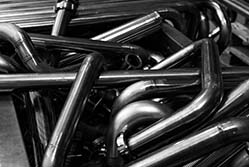MELLING PRODUCTS: Value Stream and Kaizen Yields Nearly 400% Improvement
We have been trying to do more Lean principles through our plant. The Center really helped in guiding us to learn more and make a huge improvement to one of our lines through their training and guidance.
-- Rochelle Geeck, Continuous Improvement Manager
Melling Products (www.melling.com) serves the global transportation original equipment and aftermarket segments and is noted for its world-class engineering, product development, and distribution capabilities. Melling Products, a division of Melling Tool since 1981, specializes in the engineering and fabrication of round and rectangular tubular products for customers in several industries. Melling differentiates itself in the industry by having a full-service, in-house engineering team that will work with clients from project start to finish. They handle design, development, prototype and testing of tube products. They are a contract manufacturer to both Tier I and Tier II suppliers in the automotive industry. Their services include tube bending, tube fabrication, tube forming, swaging, end forming, piercing, tube welding, assembly stamping and brazing. Melling Products employs 65 at their Farwell, Mich. location.
Challenge
Melling Products was experiencing a lot of waste, scrap and inefficiencies on their 883 line. The inefficient process used a significant amount of labor. Chris Tibaudo, Business Solutions Manager from Michigan Manufacturing Technology Center-Northeast (The Center-NE), met with the Plant Manager, Continuous Improvement Manager and the Lead Supervisor. After the meeting with Melling Products, Tibaudo reached out to The Center’s Traverse City regional office, and collaborated with Kevin Olds, Senior Business Advisor, Lean Consultant and Lean Six Sigma Black Belt.
Solution

After touring the facility, it was decided to conduct a Value Stream Mapping (VSM) event and a Kaizen scoped from the findings of the VSM. The team held a few virtual meetings and set up the logistics of the event. The first two days consisted of Lean Principles training and the VSM event to get everyone speaking the same language and scoping the project based on the findings. Three main objectives were identified:
- Improve productivity (which had a base of 22 parts per hour)
- Achieve a Takt Time to meet customer demand
- Reduce scrap by 10%
The next steps consisted of:
- Measurement System Analysis Gage R&R to determine capability of measurement devices, and redesigned go-no go gages to improve quality decision making
- Redesigned face plates of the stake machine to improve quality yield (reduce scrap)
- Redesigned cell layout to move from batch and queue to single piece flow (eliminated large piles of WIP and drastically reduced cycle time to meet Takt Time)
- Sequenced process steps to smooth out the flow
- Updated inspection guides to align Units of Measure (inches to mm)
- Added inspection gaging equipment to reduce travel/motion
Results
- Productivity increased from 22 parts per hour to 80 parts per hour
- Takt Time went from 5.85 minutes per part down to 0.75 minutes per part
- Scrap rate went from 17% down to 8.5%